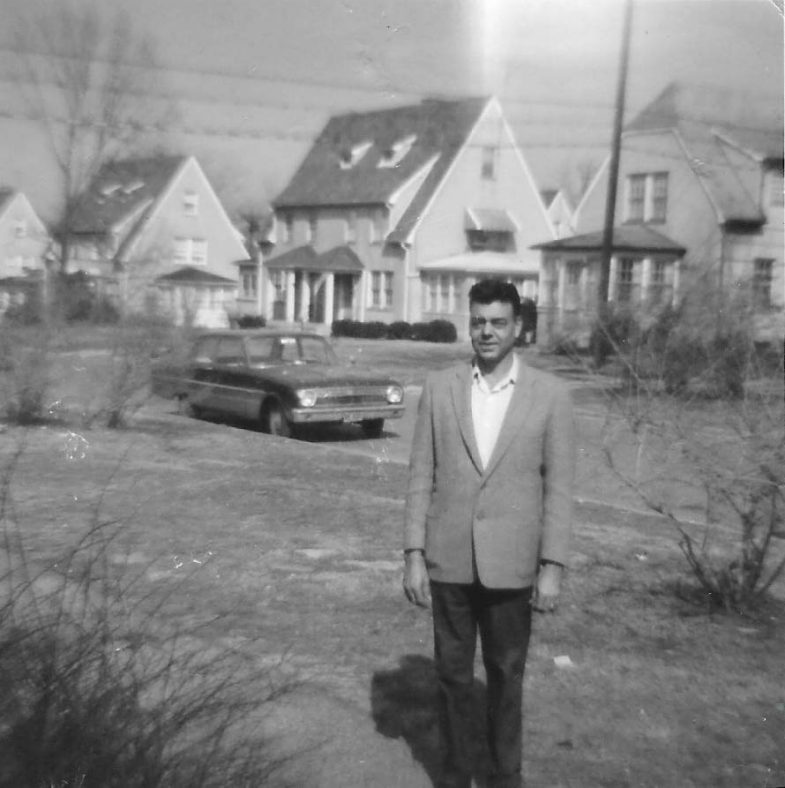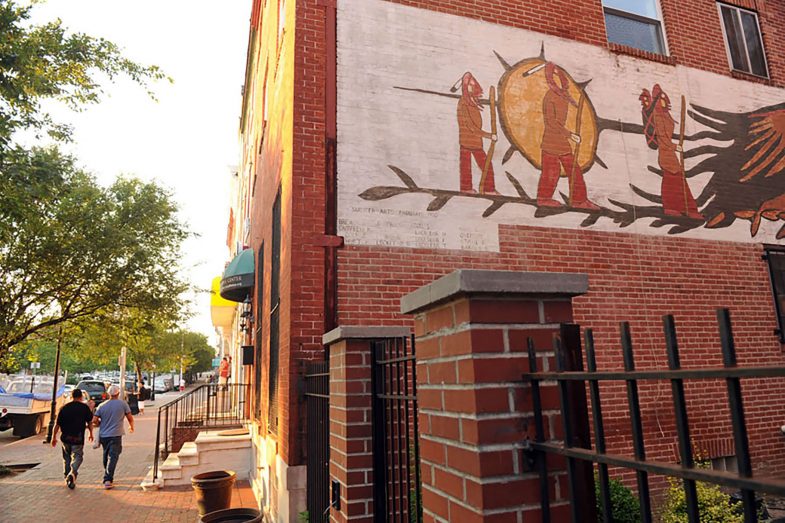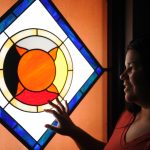Poppy, Ashley, and Magic in the back yard, Dundalk, early 1980s. This article is part of the Creating Place project. View the full multimedia collection here.
By: Ashley Minner (Baltimore, MD) | April 25, 2018
I grew up picking cucumbers and tomatoes in my grandfather’s garden. I helped him water the plants with 10-10-10 fertilizer as they grew. We ate chicken and dumplings1 and cornbread every Sunday afternoon. There were sometimes wedges of hoop cheese and hot peppers (if one dared) to go with it, cans of cold Coke to drink. Both grandparents pronounced my name “Aishley.”
You might imagine that I grew up in the Deep South, but I didn’t. This happened in Baltimore, Maryland – which is about the northernmost part of the South – though some Baltimoreans would like to argue the point. Anyway, it’s not just geographic location that makes Baltimore Southern. It’s the people.
For example, droves of Lumbee Indians2 – my grandfather included – moved from rural, southern North Carolina, to Baltimore, Maryland, following World War II. They came seeking work and a better quality of life. To what extent they could, they brought home with them. After all, they brought each other. Cousins sent for cousins, siblings for siblings, parents for their children, and vice versa. An entire Lumbee neighborhood eventually formed in East Baltimore City.
In fact, those who came couldn’t help but bring home inside of them. It was all through their speech, their cooking, their walking, their singing, their hair. North Carolina3 lay thick in the Baltimore house where my grandfather lived when I was a child, where I live now. Even today, both he and North Carolina are still here in the house, in the spaces and things that remain.
Those who came also recreated pieces of home that were left behind. My grandfather didn’t have the field here – and he really didn’t want it – but he did have a backyard that he tilled up and planted so we could eat fresh tomatoes and cucumbers and other vegetables every summer, so I would understand where my food comes from, where I come from.
Of course, I also grew up picking crabs and going to snowball stands. We sat on stoops, visiting with family and friends. We walked to the parks to play. Home was full of North Carolina, but it was Baltimore. It is Baltimore. Home is a process – always becoming, always influenced by where you are and who you’re with.
Culture is also a process. It’s a living thing. Lumbee people, especially, should understand this.
“The Lumbee Tribe of North Carolina is the largest tribe east of the Mississippi River, and the ninth largest tribe within the United States. Our homeland is a southern part of eastern North Carolina; our people mainly reside in Robeson, Hoke, Cumberland and Scotland counties. We take our tribal name from the Lumbee River, which winds through the homeland, otherwise characterized by pines, farmland and swamps. We are the present-day descendants of the Cheraw and other Siouan-speaking groups from the same region, and have African American and European ancestry, as well.4 Lumbees escaped Indian Removal5 through early assimilation, and, to an extent, through geographic isolation. Lumbee people became Christian, English-speaking and landowners soon after contact with European colonists.”6
Like any other cultural group in the world, Lumbee got to be Lumbee7 over time. Our process, in particular, has required a lot of faith, prayer, a good relationship with and knowledge of our homeland, partnership, sacrifice, fighting, adaptation, visionary leadership, and the special kind of creativity that comes out of necessity. That’s how we’ve managed to survive and how we continue to survive the systematic erasure of indigenous people on this land, the hallmark of settler colonialism. The dialect of English that Lumbee people speak is as much a part of Lumbee culture as is the way many Lumbee choose to worship God – in Baptist churches – or our chicken and dumplings and cornbread Sunday dinners.
In many ways, moving to a place like Baltimore was a tremendous sacrifice and hardship, in the name of survival, for the Lumbee people who chose to do so. While life could be very difficult at home in North Carolina – many of our people worked as sharecroppers and Jim Crow was still in effect during the height of Lumbee migration – these folks left their extended families, their communities, their all-Indian schools and churches when they came further north. They left a place where they were understood and moved to a place where they were not.
As Omi and Winant explain in their classic text, Racial Formations in the United States:
“One of the first things we notice about people when we meet them… is their race. We utilize race to provide clues about who a person is. This fact is made painfully obvious when we encounter someone whom we cannot conveniently racially categorize—someone who is, for example, racially “mixed” or of an ethnic/racial group with which we are not familiar. Such an encounter becomes a source of discomfort and momentarily a crisis of racial meaning. Without a racial identity, one is in danger of having no identity.
Our compass for navigating race relations depends on preconceived notions of what each specific racial group looks like…The content of such stereotypes reveals a series of unsubstantiated beliefs about who these groups are and what ‘they’ are like.”8
Baltimore was known to be then, as it is today, a black and white city. Lumbee were, and are still, a minority on this cultural landscape. Not black, not white, and mostly not recognized by non-Indians for being Indian – Lumbees defied stereotypes about Indians which were popularized by Westerns of the time – our people did indeed encounter discomfort and threats to their identity here in the city.
Almost right away, they set to making safe spaces to inhabit – home away from home. There was the neighborhood they eventually came to dominate, for a time, through sheer numbers. Then there were the informal spaces they frequented, neighborhood bars and restaurants.9 They made spaces to practice their spirituality, to worship in their own way. At first, they had no physical church, so they held church in houses, but soon, they were able to rent different facilities across town. They raised money to do this by cooking and selling their cultural foods: bbq, fried chicken, chicken and pastry, etc. Fundraising in this same way, Lumbee people were eventually able to found South Broadway Baptist Church in the neighborhood. From the fellowship hall of that church, and from the hearts of the people, grew the American Indian Study Center, which would later become the Baltimore American Indian Center, located one block north of the church. The Indian Center became a space for every other kind of cultural practice from (more) cooking to (more) eating to dancing to socializing to planning to just being. One of the elder leaders of the community, Linda Cox, explains that, as an Indian person, in the Baltimore American Indian Center, “[You] feel more comfortable […] and you don’t have to tell nobody who you are. You can just be you when you’re around your own people. They can respect you for who you are.”10
As part of the Center, Lumbee people also founded a daycare, which was a source of employment for young Indian mothers and a space for Indian children to grow together. Adjoining the daycare was the Center’s Native American Senior Citizens building, where our elders gathered to cook, eat, talk, and make art together. At different times, the Center also owned a store / trading post, a restaurant, and housing. Lumbee people in Baltimore even established a Title VII Indian Education Program in the public school system, through which different spaces in the schools most attended by Indian children were designated as their own.
The old neighborhood has changed significantly since Lumbee people first arrived on the scene. The places and the resources those first generations created for our community have changed also, but so have the needs of our people. In any (and every) case, we’re still here. We make ways to stay.
“Creative placemaking” is a relatively new term, but the practices to which it is intended to refer are not new at all. I understand it to be a capitalist appropriation of what have essentially been the survival strategies of our people – and others – who know what it is to make a place out of no place, to make a way out of no way. It’s not just what we do, it’s who we are. Whenever I smell fresh tomatoes from the garden, or bite into a fresh cucumber, with just the right amount of salt, or see 10-10-10 in the hardware store, I am reminded.
. . .
Ashley Minner is a community based visual artist, folklorist and storyteller from Baltimore, Maryland. A member of the Lumbee Tribe of North Carolina, she has been active in the Baltimore Lumbee community for many years, and regularly visits communities throughout the US South and Latin America as well. She is most inspired by the beauty of everyday people.
1 Chicken and dumplings is sometimes referred to, in Lumbee communities, as “chicken and pastry” or “chicken and paster.”
2 Members of neighboring tribes also came, but Lumbee made (and make) up the majority of the Indian population in Baltimore.
3 Here, I’m using “North Carolina” to mean “home” in the Lumbee Indian community where my grandfather was raised.
4 See http://www.lumbeetribe.com
5 The Indian Removal Act, passed by the United States Congress in 1830, was a policy whereby American Indian people were forcibly removed from their ancestral homelands in the eastern United States to lands west of the Mississippi River, thereafter known as “Indian Territory.”
6 Ashley Minner, “Standing in the Gap: Lumbee Cultural Preservation at the Baltimore
American Indian Center,” in The Routledge Companion to Intangible Cultural Heritage, eds. M. Stefano and P. Davis, (London and New York: Routledge, 2016.), 387.
7 Our tribe did not formally adopt the name “Lumbee” until 1956.
8 Michael Omi and Howard Winant, “Racial Formations,” in Race, Class, and Gender in the United States: An Integrated Study, Seventh Edition, ed. Paula S. Rothenberg (New York: Worth Publishers, 2007), 16.
9 Some Lumbee were able to sit down and eat inside of restaurants for the first time in Baltimore.
10 Cox, Linda. Interview with author, Baltimore, August 6, 2011.





